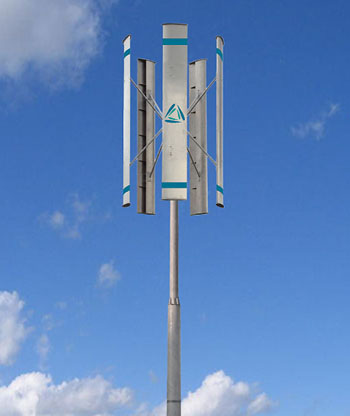For awhile it looked like vertical axis wind turbines would take over as next generation turbine technology – they were cheaper to build and maintain, quieter, required less space and were safer for birds and bats.
But horizontal axis turbines have continued to dominate because they are more reliable and efficient and have come way down in cost.
Now, several companies are giving vertical turbines a try again, such as startup Wing Power Energy, which is building the "world’s most efficient vertical axis wind turbine."
It’s starting small, with 2-kilowatt models that are 34-feet tall, and are designed to work well in low and high speed winds.
Verizon Wireless is testing a version that combines vertical wind with solar – it’s powering cellular wireless network equipment and digital surveillance cameras in Salem, Massachusetts.
Hundreds of vertical turbines were installed in California during the 1980s, but reliability issues with their aluminum blades and inflated maintenance costs forced them all out of service, Paul Gipe of Wind-Works told Scientifican American. "Right now, no one produces one that is more cost effective than a conventional wind turbine."
Other companies trying to gain a foot-hold for vertical turbines are Venger Wind, Wepower Eco and Urban Green Energy. While their designs offer efficiency gains of 10%-15%, they still haven’t addressed reliability issues stemming from their aluminum blades (they need to function for 20 years) and have a long way to go on price.

Still, they are seeing interest from some commercial customers. Urban Green Energy’s technology is being used in the world’s first wind-powered electric vehicle charging station in Spain. In Oklahoma, Venger’s 4.5 kW turbine is part of the largest building integrated wind installation in the US – atop the roof of a medical research center.
Wing Power has attracted $2 million in seed capital and is working on its first institutional round this year to commercialize the technology.
"We believe that verticals will ultimately rule the day and replace horizontals because of their innate benefits," Wind Power CEO Harry Ruda told Scientific American. "One of our missions is to prove this theory by starting with modeling 100 kilowatt capacity turbines and then moving to megawatt.
Here is Wind Power’s website:
